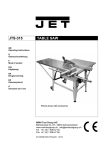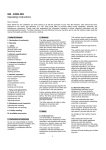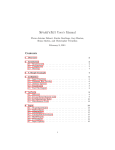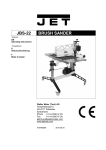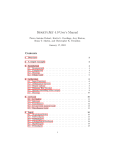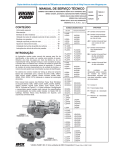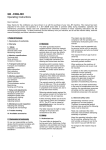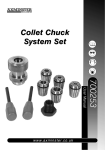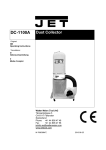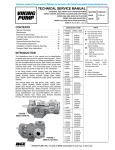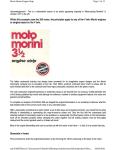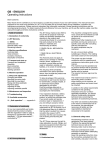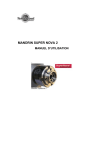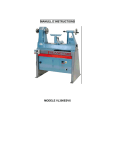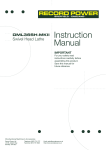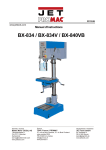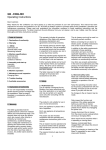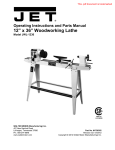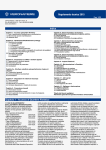Download User Manual - Axminster Power Tool Centre
Transcript
4224B WOOD LATHE Original: GB Operating Instructions Translations: D Gebrauchsanleitung F Mode d´emploi Walter Meier (Tool) AG Tämperlistrasse 5 CH-8117 Fällanden Switzerland Phone +41 44 806 47 48 Fax +41 44 806 47 58 [email protected] www.jettools.com M-1794224BM 2012-11-21 CE-Conformity Declaration Product: Wood Lathe 4224B Stock Number: 1794224BM Brand: JET Manufacturer: Walter Meier (Tool) AG, Tämperlistrasse 5, CH-8117 Fällanden, Switzerland On our own responsibility we hereby declare that this product complies with the regulations * 2006/42/EC * 2004/108/EC * 2006/95/EC * 2002/95/EC Machinery Directive EMC Directive (Electro Magnetic Compatibility) Low Voltage Directive RoHS Directive (Reduction of Hazardous Substances) designed in consideration of the standards ** EN ISO 12100-1, EN ISO 12100-2, EN ISO 13857, EN 349, EN 953, EN 60204-1, EN ISO 11202, EN 61000-6-4, EN 61800-3, EN 55011, EN 55014-2, EN ISO 14121-1 Technical file compiled by: Hansjörg Brunner, Product Management 2012-11-21 Eduard Schärer, General Manager Walter Meier (Tool) AG, Tämperlistrasse 5, CH-8117 Fällanden, Switzerland 2 GB - ENGLISH Operating Instructions Dear Customer, Many thanks for the confidence you have shown in us with the purchase of your new JET-machine. This manual has been prepared for the owner and operators of a JET 4224B wood lathe to promote safety during installation, operation and maintenance procedures. Please read and understand the information contained in these operating instructions and the accompanying documents. To obtain maximum life and efficiency from your machine, and to use the machine safely, read this manual thoroughly and follow instructions carefully. …Table of Contents 1. Declaration of conformity 1. Declaration of conformity On our own responsibility we hereby declare that this product complies with the regulations* listed on page 2. Designed in consideration with the standards**. 2. Warranty 3. Safety Authorized use General safety notes Remaining hazards 4. Machine specifications Machine description Technical data Noise emission Contents of delivery 5. Transport and start up Transport and installation Assembly Mains connection Dust collection Compressed air connection Starting operation 6. Machine operation Correct operating position Tool selection Speed selection Turning between centres Bowl turning Sanding and Finishing 7. Setup and adjustments Changing spindle speeds Headstock spindle lock Headstock spindle index Installing work holding Adjusting tool rest Adjusting tailstock Installing bed extension Installing bed extension kit 2. Warranty The Seller guarantees that the supplied product is free from material defects and manufacturing faults. This warranty does not cover any defects which are caused, either directly or indirectly, by incorrect use, carelessness, accidental damage, repair, inadequate maintenance or cleaning and normal wear and tear. Guarantee and/or warranty claims must be made within twelve months from the date of purchase (date of invoice). Any further claims shall be excluded. This warranty includes all guarantee obligations of the Seller and replaces all previous declarations and agreements concerning warranties. The warranty period is valid for eight hours of daily use. If this is exceeded, the warranty period shall be reduced in proportion to the excess use, but to no less than three months. Returning rejected goods requires the prior express consent of the Seller and is at the Buyer’s risk and expense. Further warranty details can be found in the General Terms and Conditions (GTC). The GTC can be viewed at www.jettools.com or can be sent by post upon request. The Seller reserves the right to make changes to the product and accessories at any time. 3. Safety 3.1 Authorized use 8. Maintenance and inspection Adjusting bed clamping Changing belt and bearings This wood lathe is designed for turning wood only. Machining of other materials is not permitted and may be carried out in specific cases only after consulting with the manufacturer. 9. Trouble shooting The workpiece must allow to safely be loaded and supported. 10. Environmental protection The proper use also includes compliance with the operating and maintenance instructions given in this manual. 11. Available accessories The machine must be operated only by persons familiar with its operation and maintenance and who are familiar with its hazards. The required minimum age must be observed. The machine must only be used in a technically perfect condition. When working on the machine, all safety mechanisms and covers must be mounted. In addition to the safety requirements contained in these operating instructions and your country’s applicable regulations, you should observe the generally recognized technical rules concerning the operation of woodworking machines. Any other use exceeds authorization. In the event of unauthorized use of the machine, the manufacturer renounces all liability and the responsibility is transferred exclusively to the operator Keep children and visitors a safe distance from the work area. Do not operate the electric tool near inflammable liquids or gases. Observe the fire fighting and fire alert options, for example the fire extinguisher operation and place. Do not use the machine in a dump environment and do not expose it to rain or direct sunlight. Wood dust is explosive and can also represent a risk to health. Dust form some tropical woods in particular, and from hardwoods like beach and oak, is classified as a carcinogenic substance. Always use a suitable dust collection device Before machining, remove any nails and other foreign bodies from the workpiece. 3.2 General safety notes Woodworking machines can be dangerous if not used properly. Therefore the appropriate general technical rules as well as the following notes must be observed. Make sure to guide and hold the chisel with both hands safe and tight during machining. Work only with well sharpened tools. Read and understand the entire instruction manual before attempting assembly or operation. Machine only stock which is chucked securely on the machine, always check before switching the machine on. Keep this operating instruction close by the machine, protected from dirt and humidity, and pass it over to the new owner if you part with the tool. Continuous compressed air supply must be assured for vacuum chucking. The chucking surface must be big enough to ensure sufficient vacuum forces. The workpiece must be homogenous and thick enough to avoid air leakage and pressure loss. No changes to the machine may be made. Daily inspect the function and existence of the safety appliances before you start the machine. Do not attempt operation in this case, protect the machine by unplugging the mains cable. If reversing spindle rotation, make sure face plate or vacuum chuck is secured with the set screws. Remove all loose clothing and confine long hair. Provide workpieces with centre holes before clamping between centres. Before operating the machine, remove tie, rings, watches, other jewellery, and roll up sleeves above the elbows. Work large and unbalanced workpieces at low spindle speed only. Wear safety shoes, never wear leisure shoes or sandals. When sanding, remove the tool rest from the machine. Always wear the approved working outfit. Workpieces with cracks may not be used. Do not wear gloves. Remove the chuck key or dowel pins before turning the machine on. Wear goggles when working Install the machine so that there is sufficient space for safe operation and workpiece handling. Keep work area well lighted. Always close the belt cover. Specifications regarding the maximum or minimum size of the workpiece must be observed. The machine is designed to operate in closed rooms and must be placed stable on firm and levelled table surface. Test each set-up by revolving the work by hand to insure it clears the tool rest and bed. Check setup at the lowest speed before you increase to the operating speed. Make sure that the power cord does not impede work and cause people to trip. Do not remove chips and workpiece parts until the machine is at a standstill. Keep the floor around the machine clean and free of scrap material, oil and grease. Never stop work pieces with the hand during run out. Stay alert! Give your work undivided attention. Use common sense. Do not operate the machine when you are tired. Keep an ergonomic body position. Maintain a balanced stance at all times. Do not operate the machine under the influence of drugs, alcohol or any medication. Be aware that medication can change your behaviour. Never reach into the machine while it is operating or running down. Never leave a running machine unattended. Before you leave the workplace switch off the machine. Do not attempt to engage the spindle lock pin until the spindle has stopped. Never take measurements on a rotating workpiece. Do not stand on the machine. Do not obstrukt the air flow on heat sinks of AC-drive (allow natural cooling). Connection and repair work on the electrical installation may be carried out by a qualified electrician only. (Warning: Wait five minutes for DC-bus capacitors discharge before accessing the AC drive unit.) Have a damaged or worn power cord replaced immediately. Make all machine adjustments or maintenance with the machine unplugged from the power source. 3.3 Remaining hazards When using the machine according to regulations some remaining hazards may still exist. The rotating workpiece can cause injury. Workpieces that are inhomogeneous or weak can explode when being processed due to centrifugal force. Only process selected woods without defects. Unbalanced workpieces can be hazardous. I 350mm toolrest J Comparator support K Live centre L Tailstock with laser etched scale M Tailstock with storage cavity N Tailstock handwheel O Powerful 3 horsepower motor P Tool caddy with tools Q Front-mounted controls R Integrated vacuum system S Remote control T Heavy cast iron bed with precision ways U Cast iron legs V Ledges for shelf support W Leveling feet Loss off compressed air supply can be hazardous. Injuries can occur when feeding tooling, if tool supports are not correctly adjusted or if turning tools are blunt. Risk of kickback. The tooling is caught by the rotating workpiece and thrown back to the operator. Thrown workpieces and workpiece parts can lead to injury. Dust and noise can be health hazards. Be sure to wear personal protection gear such as safety goggles and dust mask. Use a suitable dust collection system. The use of incorrect mains supply or a damaged power cord can lead to injuries caused by electricity. 4. Machine specifications 4.1 Machine description 4.2 Technical data Swing over bed 610mm Swing over tool rest base 490mm Centre distance 1067mm Number of mechanical speeds 3 Spindle speed range L 0 - 910 rpm Spindle speed range M 0 - 2000 rpm Spindle speed range H 0 - 3500 rpm Spindle nose M33x3,5 DIN 800 Headstock spindle taper MT 2 Spindle index lock 14x25.7°, 36x10°, 48x7.5° Spindle hole diameter 15,8mm Tailstock spindle taper MT 2 Tailstock hole diameter 9,5mm Tailstock ram travel 115mm Centre above floor 1120mm Overall (LxWxH) Leg footprint (LxW) Net weight Mains Output power Reference current Extension cord (H07RN-F): Installation fuse protection Isolation class Compressed air supply 2260x710x1651mm 1600x610mm 395 kg 1~230V, PE, 50Hz 2,2 kW (3 HP) S1 12 A 3x1,5mm² 16A I 6,5bar ( 90psi) 4.3 Noise emission Acoustic pressure level (EN ISO 11202): Idling In operation Fig 1 A B C D E F G H Vacuum connection 98-position indexing system Spindle lock Sliding headstock Belt drive access door Digital read out Vaccum chuck Guard LpA 72,5 dB(A) LpA 78,4 dB(A) The specified values are emission levels and are not necessarily to be seen as safe operating levels. As workplace conditions vary, this information is intended to allow the user to make a better estimation of the hazards and risks involved only. 4.4 Content of delivery Casting legs with levelling pads 350 mm tool rest 75 mm face plate Spur centre and tooling knockout bar Live centre Guard Comparator centres Tool caddy Vacuum adaptor and support bracket Vacuum chuck Air blow gun with house Remote ON/OFF switch Operating tools Assembly kit Operating manual Spare parts list. Dispose of the packing in an environmentally friendly manner. Clean all rust protected surfaces with a mild solvent. Attach the leg stand: At this point the headstock, tailstock and tool rest should be removed. The machine is heavy! Get the help of a second person. Loosen both headstock cams (A, Fig 3) with provided wrench to position the head along the lathe bed. Fig 3 Remove the stop pin (B) to slide the headstock off the bed. Carefully turn bed upside down on skid. Make sure nothing is beneath that would scratch the bed ways. Prevent damage to the JET-Logo plate. Attach the leg stand with 8 hex socket cap screws, lock washers and flat washers (A, Fig 4-1). Fig 2 5. Transport and start up Fig 4-1 Install leveling feet and tighten nuts against the leg (Fig 4-2). 5.1 Transport and installation The machine is designed to operate in closed rooms and must be placed stable on firm and levelled ground. The machine can be bolted down if required. For packing reasons the machine is not completely assembled 5.2 Assembly If you notice transport damage while unpacking, notify your supplier immediately. Do not operate the machine! Fig 4-2 Turn bed upside down. Adjust the feet so that the lathe rests evenly on the floor. Reinstall headstock, tool rest and tailstock. Note: If installing the 508mm bed extension Kit (#6294900E, optional), the right leg and bed end surfaces must be flush. If you are bolting the lathe to the floor, you need to block up the legs by 40mm to allow sufficient clearance for the elevating post. Tool caddy assembly: Mount the tool caddy with two screws and lock washers to the left leg (Fig 5) Fig 7-1 Fig 5 Note: The tailstock body can also be used to store tools (Fig 6). Fig 7-2 Fig 6 Stand shelf: You can install an extra shelf that rests between the legs if you wish. There are different possibilities (see Fig 7-1 to 7-3). Fig 7-3 Optical comparator assembly: Mount the comparator brackets (C and D, Fig 10) to the back of the headstock and tailstock with socket head cap screws and lock washers. Fig 11 Fig 8 The tailstock bracket has elongated holes, so it can be aligned with the headstock bracket. There are two detents that will hold the guard in place. One is for turning and the other is for when you need the guard up and out of the way. The comparator allows to hold a sample workpiece for optical reference and comparative measurement taking. ( see Fig 9-10). Tighten the bushings (B) against the bracket with two set screws (C). Fig 12 Fig 9 5.3 Mains connection Mains connection and any extension cords used must comply with applicable regulations. The mains voltage must comply with the information on the machine licence plate. The mains connection must have a 16 A surge-proof fuse. Only use power cords marked H07RN-F Connections and repairs to the electrical equipment may only be carried out by qualified electricians. 5.4 Dust collection Fig 10 Guard assembly: Attach the guard to the bracket by inserting the rod and lifting up on the plunger (A, Fig 11). Use a suitable dust collection and air filtration system to avoid high dust concentrations in the air. 5.5 Compressed air connection To use the vacuum chuck and the blow gun, the machine must be connected to compressed air. Compressed air supply 6,5bar ( 90psi) Connect blow gun hose (A, Fig 13) to the T-connector. Connect your incoming air supply to the quick connect coupler (B). 5.6 Starting operation You can start the machine by pulling the red ON/OFF button (I, Fig 15). Fig 13 Attach vacuum adaptor (C) to hose (D). Push adaptor into the spindle. Install support bracket (E, Fig 14) with knurled screw. This prevents adaptor from backing out during spindle rotation. Fig 15 The machine will stop when you push the red ON/OFF button (I, Fig 15) or the remote control ON/OFF button (Fig 16). Fig 16 Fig 14 Rotate the switch (H, Fig 15) to activate or to deactivate the vacuum air flow . The vacuum gauge (R) shows the vacuum pressure achieved in cmHg (80cmHg=1bar). Turn the knob (K) to the desired RPM. There are 3 speed ranges, offering -“speed” (high range 0-3500 rpm) -”general use” (medium 0-2000 rpm) - “torque” (low range 0-970 rpm). Caution: Continuous compressed air supply must be assured for vacuum chucking. The chucking surface must be big enough to ensure sufficient vacuum forces. The workpiece must be homogenous and thick enough to avoid air leakage and pressure loss. The RPM Readout shows the spindle speed If reversing spindle rotation, make sure face plate or vacuum chuck is secured with the set screws. Always support the tool on the tool rest and guide with the palm of your hand keeping your fingers closed. (see Fig. 18 ) Use the switch (J) to reverse the spindle direction. 6. Machine operation 6.1 Correct operating position Skew Chisel (C, Fig 19), used to make vees, beads, etc. (Fig 21). The bevel of scew is parallel to the cut. Fig 21 Parting tool (D, Fig 19), used to cut directly into the material, or to make a cut off. Also used for scraping and to set diameters. 6.3 Speed selection: Fig 18 6.2 Tool selection Successful wood turning does not result from high speeds, but rather, from the correct use of turning tools. A perfect and sharp wood turner tool is a precondition for professional wood-turning. Major tools: Fig 19 Gouge (A, Fig 19), used for rapidly cut raw wood into round stock, for turning bowls and plates, for turning beds, coves and other detail (Fig 20). Fig 20 Scraper (B, Fig 19), used for diameter scraping and to reduce ridges. Use low speeds for roughing and for large diameter work. If vibrations occur, stop the machine and correct the cause. See speed recommendations. Speed recommendations Workpiece Diameter mm Roughing RPM General Cutting RPM Finishing RPM < 50 1500 3200 3500 50-100 700 1600 2500 100-150 500 1100 1600 150-200 370 800 1200 200-250 300 650 1000 250-300 250 500 800 300-350 220 450 700 350-400 180 400 600 6.4 Turning between centres With a ruler locate and mark the centre on each end. Put a dimple in each end of the shock. Extremely hard woods may require kerfs cut into the spur drive end of stock (see Fig 21). Fig 24 Fig 21 The spur drive centre locks into the cleaned spindle taper and can be removed with the knockout rod (Fig 22) 6.5 Bowl turning Turn outside of bowl between centres. Turn a short tenon the size of the hole in the faceplate (A, Fig 25). This will allow centring the workpiece. Fig 22 Mount the centred workpiece between the spur drive centre and the tailstock mounted live centre Turn the tailstock hand wheel until the live centre well penetrates the workpiece. Reverse the hand wheel by one quarter turn and lock the tailstock spindle. Turn the workpiece by hand to see if it rests securely between centres and can be rotated freely. For turning between centres the tool rest is set appr. 3mm higher than centre line (Fig 23 and 24). Fig 25 Mount the workpiece (A, Fig 26) directly to the face plate using 4 wood screws (C) from the back. Be careful to use screws short enough not to interfere with the cutting process but long enough to hold the workpiece securely to the face plate. If screw mounting is not allowed at all, the work may be glued to a backing block (D) and the backing block screwed to the face plate. A piece of paper in the glue joint will prevent damaging the wood when separated later. Mount the face plate with the workpiece already attached onto the spindle nose thread and hand tighten. Move tailstock away, remove centre from tailstock to prevent injury. Turn the workpiece by hand to see if it rests securely and can be rotated freely. Fig 23 7. Setup and adjustments General note: Setup and adjustment work may only be carried out after the machine is protected against accidental starting by pulling the mains plug. 7.1 Changing speed range Disconnect the machine from the power source! Loosen the locking screw and open the belt cover. Loosen the locking handle (A, Fig 28). Fig 26 For face plate turning the tool rest is set slightly lower than centre line. Caution: Cut with your chisel on the left side of the turning centre only. Use left hand to control cutting edge of gouge, while right hand swings tool handle around toward your body (Fig 27). Fig 28 Lift up on the tensioning handle (B) to remove tension from the poly v-belt. You can now position the belt in the desired speed range. Note: “High” speed range (0 - 3500 rpm) for maximum speed. Fig 27 “Medium” speed range (0 - 2000 rpm) for general use Try to make one, very light continuous movement from the rim to the bottom of the bowl to ensure a clean, sweeping curve through the workpiece. “Low” speed range (0 - 910 rpm) for maximum torque. Move tool support to the exterior to re-define bottom of bowl. 6.6 Sanding and Finishing Remove the toolrest and begin with a fine grit sandpaper (120 grit) and progress through each grit, using only light pressure. Use power sanding techniques to avoid concentric sanding marks. Finish sanding with 220 grit. Apply first coat of finish. Allow to dry before sanding again with 320 or 400 grit sandpaper. Turn lathe back on and make a separation cut through the base. Stop at about dia. 80mm and use a fine tooth saw to separate the bowl from the waste. Apply additional finish coats and allow to dry before buffing. Lower the tensioning handle so that the weight of the motor provides the needed tension and tighten the locking handle. Close and lock the belt cover. Warning: The AC Inverter does not require any programming. It is preprogrammed from the factory. The buttons and knob on the inverter should not be changed. 7.2 Headstock spindle lock Push in pin (G, Fig 29) to stop the spindle from turning. Slide down the bracket (F) to hold in place. 7.4 Installing work holding The faceplate is used for tuning bowls. There are a number of holes for mounting the workpiece. Thread the faceplate onto the spindle in a clockwise direction, and tighten two set screws (E, Fig 31). Fig 29 Caution: Never press the spindle lock while the spindle is turning! 7.3 Headstock spindle index The handwheel has 3 arrays of holes 14x25.7°, 36x10°, 48x7.5° The spindle nose has a matching graduation scale. Fig 31 Remove the faceplate by loosening two set screws (E). Push in the spindle lock and use the provided open spanner (F, Fig 32). Loosen handle (A, Fig 30) and position bracket until indexer pin aligns with the desired array of holes. Fig 30 Rotate spindle by observing the spindle graduation. Push indexer pin to engage the handwheel hole. Screw in indexer knob to hold in place. Caution: Do not overtighten the indexer knob, to avoid deflection. Release index pin before turning on the lathe. Never press the index pin while the spindle is turning! The indexer assembly can be removed from the lathe by unscrewing locking handle (A). Fig 32 Caution: If reversing spindle rotation, always make sure face plate or vacuum chuck is secured with the set screws. 7.5 Adjusting tool rest Position the tool rest as close to the workpiece as possible. Tighten handle (C, Fig 33) to lock. Set the height to approximately 3mm above centre line. Tighten indexable knob (D). If tool rest post begins to slip, tighten up the hex socket cap screw (E). The centering pin can be knocked out to allow deep hole drilling operations. 7.7 Installing bed extension (# 6294905E) Have an assistant hold bed extension flush to end of lathe bed, and insert four screws with washers (B, Fig 36). Snug screws just enough to hold bed extension to lathe bed. Unscrew stop bolt (A) from lathe bed and insert it into hole at end of bed extension. Fig 33 7.6 Adjusting tailstock Turn the hand wheel (P, Fig 34) clockwise to move tailstock spindle forward. Lock tailstock spindle with the indexable knob (O). Fig 36 Top surfaces and inside ways must be flush to allow smooth movement of tailstockt. Slide tailstock over joint where beds meet, so that clamping nut is centered over joint. Lock tailstock clamping handle; this will align the beds. (Fig 37). Fig 34 The handle (Q) locks the tailstock in position on the bed. The live centre can be ejected by turning the hand wheel counter-clockwise. To screw off the cone (R, Fig 35) the life center must be locked against rotation with the supplied pin (S). Fig 37 Tighten screws in extension bed. 7.8 Installing bed extension kit (# 6294900E) Fig 35 The machined surfaces of bed end and leg must be aligned flush. Use a straight edge to check (Fig 38). Fig 40 Fig 38 Install bed extension in the same manner as described in chapter 7.7 Install elevating system to bed extension with four screws and washers, and to lathe leg with three screws and washers (A, Fig 39). One screw is installed from inside the leg and secured with nylon nut (B). For outboard turning, move the headstock to opposite end of lathe. To accommodate large workpieces, you can mount the bed extension to the lower set of holes, and mount an extension post [included with kit] to the tool rest base ( Fig 40). Install handwheel and tighten sets crew. Fig 39 Note: If heavy loading makes handwheel turning difficult, a 19mm wrench can be used (Fig 40). Fig 40 For larger outboard work, a heavy outboard turning stand is available (# 708349). 8. Maintenance and inspection General notes: Maintenance, cleaning and repair work may only be carried out after the machine is protected against accidental starting by pulling the mains plug. Clean the machine regularly. Remove any foreign objects from the heat sinks of AC-drive (Do not obstruct the air flow). Inspect the proper function of the dust collection daily. Defective safety devices must be replaced immediately. Repair and maintenance work on the electrical system may only be carried out by a qualified electrician. (Warning: Wait five minutes for DC-bus capacitors discharge before accessing the AC drive unit!) 8.1 Adjusting bed clamping If adjustment is needed, remove the stop bolt on end of bed. Fig 42 Loosen and remove the clamping nut (B) and lock washer (C). Use a wood dowel, or aluminium stock to knock spindle towards the tailstock. (Use a material that is softer than the spindle so you do not mushroom end of spindle). Go only far enough to remove the belt from spindle. Slide the headstock, tailstock or toolrest to the edge of the bed and slightly turn the hex nut (B; Fig 41). To reassemble reverse the procedure. Test the clamping function and repeat if necessary. When reinstalling clamping nut, thread it on to the spindle until its snug. Then back off slightly and tighten the lock washer. Note: To remove the pulley for bearing replacement it is needed to loosen the 2 set screws (E, Fig 43). Fig 41 8.2 Changing belt and bearings Changing belt and bearings can be a difficult task. By chance, remove headstock and take into a repair station for servicing. Disconnect the machine from the power source. Open the door and remove the belt from the lower pulley. Loosen two set screws (A, Fig 42) and unscrew the handwheel. Fig 43 Make sure the pulleys are oriented properly after reassembly for straight belt runnig. 9. Trouble shooting Motor doesn’t start *No electricitycheck mains and fuse. *Defective switch, motor or cordconsult an electrician. *Overload detected on AC-drive unitwait and restart machine; chose low speed range belt setting (0-910 rpm) for better torque. *Insufficient vacuumcheck compressed air supply check chucking for air leakage Machine vibrates excessively *Stand on uneven flooradjust stand for even support. *Workpiece is not properly centred Fig 47 *The speed is too high 10. Environmental protection Stock number 6294903E Tailstock Riser Block (Fig 48) Protect the environment. Your appliance contains valuable materials which can be recovered or recycled. Please leave it at a specialized institution. 11. Available accessories Stock number 6294905E Bed Extension 508mm (Fig 44) Fig 48 Stock number 708349 Heavy outboard turning stand (Fig 46) Fig 44 Stock number 6294900E Bed Extension Kit 508mm (Fig 45) Fig 46 Fig 45 Stock number 6294904E Bed Extension 1600mm with stand (Fig 47) Stock number 709911 Face plate 75mm M33x3,5mm Stock number 709921 Face plate 150mm M33x3,5mm Stock number 709960 Spindle adapter M33x3,5 / 1”x 8TPI Stock number 709942 Four toothed spur centre MT-2 Stock number 708343K Drill chuck 13 mm, with tapered mandrell MT-2 Stock number 709960 Spindle adapter M33x3,5 / 1”x 8TPI Stock number 708332 Face shield Refer to the JET-Pricelist for various tools and work holding.


















